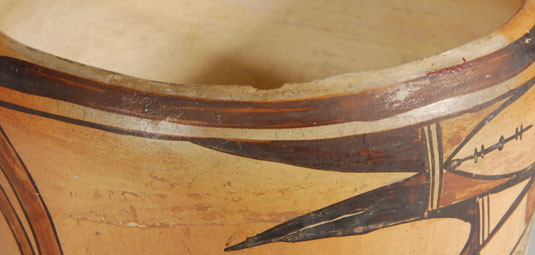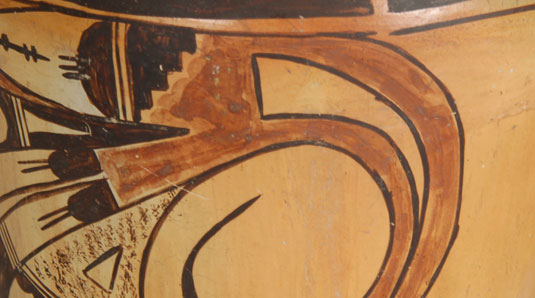Hopi-Tewa Polychrome Cylindrical Jar [SOLD]
+ Add to my watchlist Forward to Friend
- Category: Historic
- Origin: Hopi Pueblo, Hopituh Shi-nu-mu
- Medium: clay, pigment
- Size: 5-1/2” height x 5-1/4” diameter
- Item # C3801D SOLD

It is generally accepted that a potter will not knowingly copy the designs of another potter and a family of potters will not knowingly copy the designs associated with another family of potters. With that in mind, we take a look at the designs of this Hopi-Tewa cylinder.
The stylized birds on this cylinder are of the style that Nampeyo of Hano used based on her exposure to the pottery sherds being excavated at the prehistoric ruins of Sikyatki. Nampeyo is known to not have copied the designs of the Sikyatki potters, but to have been inspired by them and based her designs on what she saw.
The birds on this cylinder each have a beautifully curved black beak at the end of a beautifully curved red neck. Nampeyo achieved this curve using a brush made from a yucca leaf by which she made one long sweeping move of her hand. Mark Tahbo remarked to us that a yucca brush will hold enough paint to make a long curve like this but a commercial brush goes dry before completing such a curve.
The pair of black finger-nail-like elements on the bird’s wing, each of which has a pair of thin lines, have been associated with pottery by Nampeyo on many occasions and it has been stated that such design represents clouds and rain. We see that symbol repeated on the birds tail feathers near the rim where it has three thin lines representing rain. Stippling, as seen in the design, surrounding a small triangle, is most definitely associated with the hand of Nampeyo.
It is for these reasons that we are attributing this cylinder to Nampeyo. Did Nampeyo paint the design or did her daughter Annie Healing do so for her mom? I don’t know that there is a way to make that determination with any degree of accuracy. Nampeyo and Annie often worked together and would place all their pottery together on a blanket and together sit, chat, and sell their wares, with little interest by the buyer as to who made what and who painted what.
Condition: very good structural condition, with some scratches on the surface, a small rim chip on the interior and some very minor abrasion to the paint. It appears that the cylinder has previously been used as a pencil and pen holder as there are spots of ink on the interior base.
Provenance: from a gentleman collector from Texas
Recommended Reading: Canvas of Clay - Seven Centuries of Hopi Ceramic Art by Edwin L. Wade and Allan Cooke

- Category: Historic
- Origin: Hopi Pueblo, Hopituh Shi-nu-mu
- Medium: clay, pigment
- Size: 5-1/2” height x 5-1/4” diameter
- Item # C3801D SOLD



